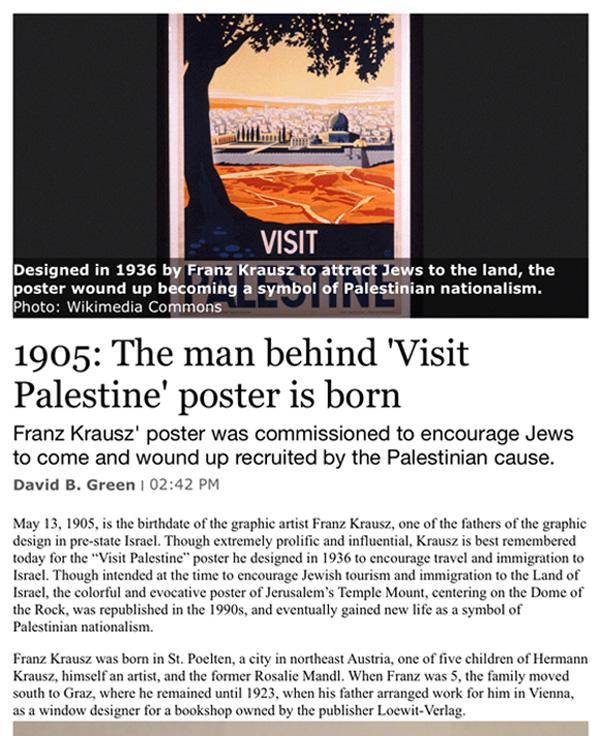May 13, 2016 7:00 AM
Haaretz
May 13, 1905, is the birthdate of the graphic artist Franz Krausz, one of the fathers of the graphic design in pre-state Israel. Though extremely prolific and influential, Krausz is best remembered today for the “Visit Palestine” poster he designed in 1936 to encourage travel and immigration to Israel. Though intended at the time to encourage Jewish tourism and immigration to the Land of Israel, the colorful and evocative poster of Jerusalem’s Temple Mount, centering on the Dome of the Rock, was republished in the 1990s, and eventually gained new life as a symbol of Palestinian nationalism.
Franz Krausz was born in St. Poelten, a city in northeast Austria, one of five children of Hermann Krausz, himself an artist, and the former Rosalie Mandl. When Franz was 5, the family moved south to Graz, where he remained until 1923, when his father arranged work for him in Vienna, as a window designer for a bookshop owned by the publisher Loewit-Verlag.
It was during his three years in Vienna that Krausz began learning about, and being drawn to Zionism. His interest continued after he moved to Berlin, where he worked as sole graphic designer of another publisher, Friedrich Ernst Hubsch Verlag. In the evenings, he attended the Reimann Schule, an art and design school. It was there that Krausz met Anni Sass, a photographer, who became his wife.
Posters for MGM
After the rise of Hitler to power, Franz and Anni decided to move to Mandatory Palestine; while they were waiting for visas, however, they spent the years 1933 and 1934 in Barcelona. They married there, and Franz was employed designing movie posters for Metro-Goldwyn-Mayer. The couple finally arrived in Jaffa in October 1934, and set up house in nearby Tel Aviv, where they rented the two-room apartment on Beit Hasho’eva St. that they lived in until Franz’s death, 60 years later.
At the time, graphic design and the advertising field were in their infancy, and Krausz was able to play a foundational role in their establishment. In 1935, he helped to found the Society of Graphic Designers. He made a living doing both commercial and non-profit work, with clients that included Dubek tobacco, which employed Krausz over a period of 45 years, and Elite, whose familiar cow, a symbol of its milk chocolate, was designed by Kraus.
Sunny Palestine
The “Visit Palestine” commission came in 1936 from the Tourist Development Association of Palestine, whose goal was to encourage Jews to come to the country, on both a temporary and permanent basis.
At the time, the term “Palestine” didn’t have a political connotation – it simply was the historical name for the land.
Krausz designed several versions of the poster, one of which depicted Tiberias and Lake Kinneret, looking north toward Mount Hermon.
“Visit Palestine” became just one of hundreds of strong and evocative designs – generally painted on the basis of photographs taken by Anni, his wife – made by Krausz over his long career. But it might have been forgotten if not for its rediscovery in 1995 by graphic artist David Tartakover, whose second career is as an archivist and self-styled historian of Israeli graphic arts. Tartakover tracked down Krausz, still alive, and with his permission, reprinted the Jerusalem version of “Visit Palestine.”
He later said the project was a reflection of the political optimism he felt about Israeli-Palestinian reconciliation, back when the Oslo process – and Israeli Prime Minister Yitzhak Rabin – were still alive. The two printed up a limited run of 1,000 copies of the poster, and offered it for sale, mainly in museum shops. Several years later, however, when Israeli-Palestinian relations had deteriorated and the violence that evolved into the second intifada had become manifest, Tartakover began to notice that the poster was showing up, in an unauthorized version, in the Palestinian territories. Over the next decade, in fact, it became a best seller among Palestinians and supporters of their cause.
Tartakover didn’t especially mind. He told journalist Nancy Updike, in 2006, that, “I think everyone can use it the way he wants. You can’t control something you put out there.”
By then, Franz Krausz was gone. He died on April 7, 1998, at the age of 92.
by David B. Green
Source: http://www.haaretz.com/jewish/this-day-in-jewish-history/1.719286

